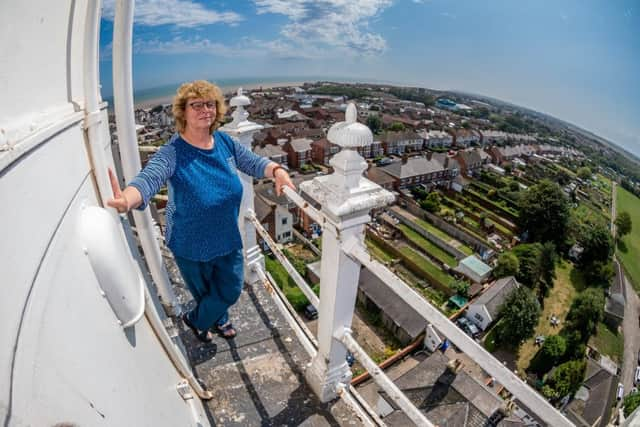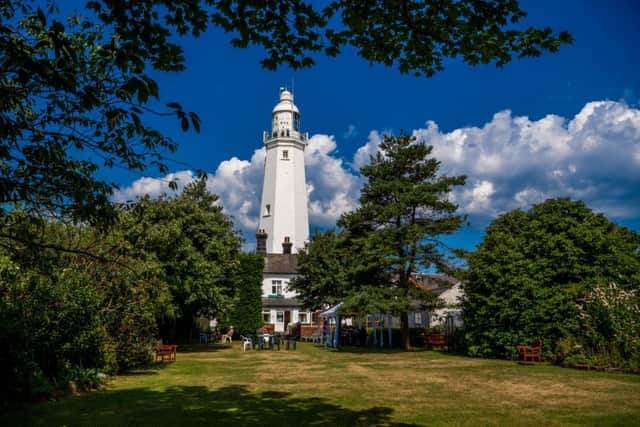Inside the Yorkshire lighthouse with link to tragic post-war Hollywood star
At 127 feet tall, Withernsea lighthouse can be seen, over the flat but green and beautiful landscape of Holderness, for miles around. When the light was flashing its two short and two long beams out to sea – the structure was decommissioned in the 1970s and put up for sale – shipping could observe this comforting aid to their navigation for 20 miles.
It had served seafarers since 1894. The brick tower, painted a brilliant white, is still a local landmark. Today, it is a museum dedicated in part to the story of the Royal National Lifeboat Institution and to the coastguards, but also, bizarrely, to a daughter of the town who was, for a few short years, one of the glittering stars of the movie industry.
Advertisement
Hide AdAdvertisement
Hide Ad

It is also one of very few lighthouses in the UK that is built inland, about a quarter of a mile from the water’s edge. That’s because the coastal erosion of late Victorian times was so severe that building anything next to the sea would have been, at best, extremely foolhardy. The lighthouse came just too late to save the town’s pier, which had been opened in 1877 and jutted out into the North Sea for more than 1,100 feet. By the time the gates closed in 1903, it was a mere 50 feet in length. No-one seemed to have thought that building a pier out into a busy shipping lane was a risky undertaking.
The landward towers still stand as a historical curiosity and have been recently restored, and now stand sentry to a flight of steps leading down to the beach.
According to Withernsea Lighthouse Museum manager Lindsey Jones, who was born and raised in the town, it was, for a few decades, a bustling seaside destination. “There are records of the number of trains that pulled into our station, bringing trippers galore,” she says. “In fact, it is said that, on one particular Saturday, 10,000 visitors arrived. There are old photographs of that time, with the promenade packed, and there were so many people on the beach that you couldn’t see the sand!”


Then came the slow decline of British seaside resorts and Withernsea felt the pinch. Perhaps the worst blow of all was the closure of the direct rail line to Hull. Lindsey says that, “within living memory”, there was entertainment by Pierrot troupes on the beaches, an open-air swimming pool and a much-loved dance and concert hall (the Grand Pavilion), which played host to big names like T Rex, Suzi Quatro and Slade until the doors were padlocked shut for the last time. There was also a celebrated market – but that too has perished. Today, the town’s main income is derived from the folk who come to stay in the nearby caravan and holiday parks.
Advertisement
Hide AdAdvertisement
Hide AdAnd that movie star? She was Kay Kendall, and she was born in the town in 1927. She had a sister, Kim, and an older brother, Terry, both of whom are still alive. Her heritage was theatrical, since her parents were talented dancers and even made it to a Royal Command performance, and her grandmother was a celebrated Edwardian actress and dancer, Marie Kendall. The family home (now with a blue plaque to Kay’s memory) still stands. It is called Stanley House, and if that sounds something rather grand, it is in fact a very neat little villa on Hull Road, a stone’s throw from the lighthouse.
She was born with the first name of Justine, but dropped that in favour of her second one, Kay. Young Kay and her sister (Patricia Kim Kendall) realised they had to leave Withernsea if they wanted to make a name for themselves on the stage. Kim – who is now 94, and lives in the US, with homes in Florida and New York – was the first one to strike lucky, and won glowing reviews for her appearance in the pre-war West End smash hit Me and My Gal.


Kay’s first credited film in 1946 was the disastrous musical London Town, such a monstrous flop that it nearly bankrupted Rank Studios. It starred the top comic of the Forties, Sid Field, and a very young Petula Clark. Kay’s own reaction to this setback was to record that, after the reviews came out, “there were no more bazaars to open, no more premieres, no more autographs”.
Then came the film which made Hollywood come calling. That movie was Genevieve, in which she starred with Kenneth More. It captured the countryside of the post-war years and London when it was still in recovery from the Blitz. “It constantly comes up in those ‘best-loved films’ lists,” says Tony Simpson, an advisor to the museum.
Advertisement
Hide AdAdvertisement
Hide AdBack on track, Kay was in the first of the Doctor series, Doctor in the House, and she worked with stars such as Peter Finch and Robert Taylor. She even appeared in an early Phil Silvers Show opposite Sergeant Bilko himself, and won a Golden Globe for her work on Les Girls, the story of three showgirls in post-war Paris. She was friends with stars like Noel Coward, Humphrey Bogart and Lauren Bacall. “You watch her, and her timing is impeccable,” says Tony. “Her zest for life just zings off the screen”.
And then came the film The Constant Husband (1955), where her co-star was the debonair Rex Harrison. They began an affair. It is fair to Harrison’s memory to say that, while he was an actor who could easily pull off the suave roles on screen, away from the camera he was nicknamed “King Rat”.


Kay began to feel unwell, and believed that she was suffering from some sort of iron deficiency. Her doctor told Rex the truth. Kay was suffering from myeloid leukaemia. Rex decided to keep the facts from her. He was already married, to the actress Lilli Palmer, and they agreed to divorce so that he could look after Kay. “For such a notorious philanderer, and such a shallow man”, says one film historian, “it was probably the nicest and noblest thing he ever did.”
Lindsey says: “It is fair to say that her family loathed Rex, they couldn’t stand him, and they thoroughly disapproved of it all.” Kay died in 1959, at the age of just 32, and still unaware of the fatal nature of her illness. Her final film, with Yul Brynner, was Once More with Feeling which came out the year after she died.
Advertisement
Hide AdAdvertisement
Hide Ad“Whenever Kay and Kim used to return to see their family in Withernsea it became the talk of the town,” says Lindsey. “People would remark on these two very glamorous ladies with their expensive clothes. They weren’t flash it was just the lifestyle they lived”.
The decommissioning of the lighthouse coincided with Kim’s decision to find herself an apartment in Withernsea so that, on visits from the US, she could be with her frail mother. When she learned that the landmark was up for sale she bought it, created her new home, and also commissioned Lindsey, then a student of graphic design, to start work on a potential museum.
Today, there is only one permanent member of staff, but this quirky little corner of the county is self-sufficient, and pulls in a footfall of about 10,000 a year. As many as came by train on that famous Saturday.
There are film buffs galore, others who enjoy the maritime heritage. Not everyone ascends the 144 steps to the very top – the staircase doesn’t go through chambers within, but snakes up the interior, so that there is a view to the floor below. “It you’ve got vertigo it’s probably not the climb for you,” says Tony.
Advertisement
Hide AdAdvertisement
Hide Ad

But it is a day out that keeps Kay Kendall’s memory vibrantly alive. “She would have been delighted to know that we now allow marriage proposals to take place in the old lightroom, all that way up,” says Lindsey. “Mind you some of the brides-to-be do take a lot of persuasion to get up there. Some of the excuses that their partners offer are more than inventive!”
Withernsea Lighthouse Museum is at 47 Hull Road. It is open weekends only until March 30 next year, 1pm to 5pm Saturdays, Noon until 4pm on Sundays. For more information call 01964 614834.